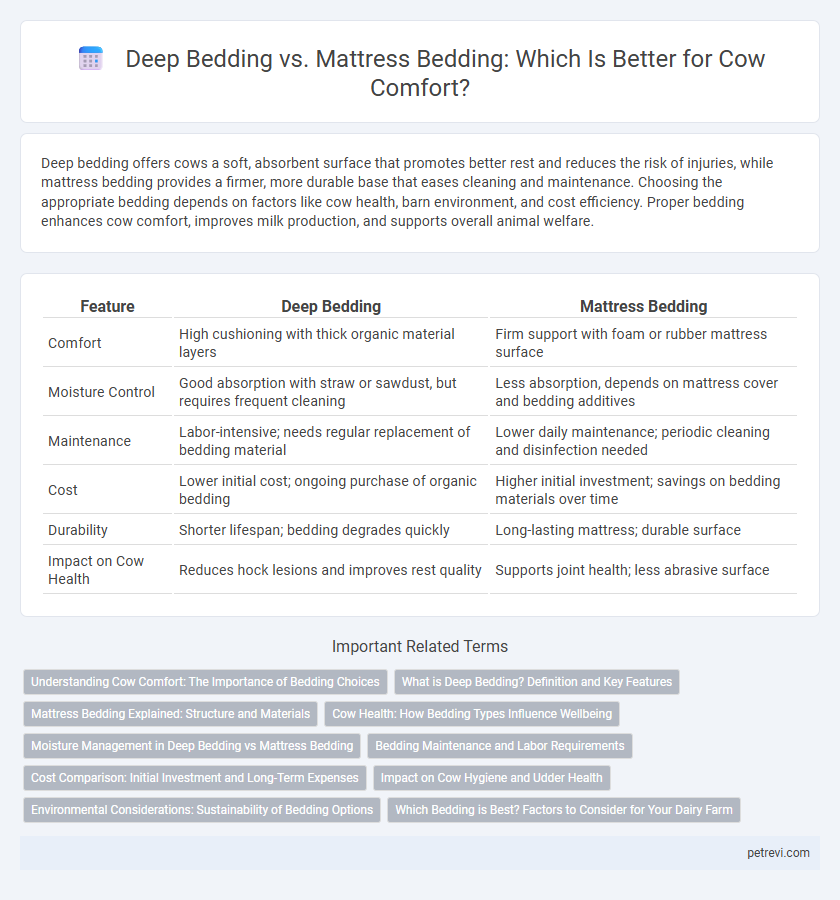Deep bedding offers cows a soft, absorbent surface that promotes better rest and reduces the risk of injuries, while mattress bedding provides a firmer, more durable base that eases cleaning and maintenance. Choosing the appropriate bedding depends on factors like cow health, barn environment, and cost efficiency. Proper bedding enhances cow comfort, improves milk production, and supports overall animal welfare.
Table of Comparison
| Feature | Deep Bedding | Mattress Bedding |
|---|---|---|
| Comfort | High cushioning with thick organic material layers | Firm support with foam or rubber mattress surface |
| Moisture Control | Good absorption with straw or sawdust, but requires frequent cleaning | Less absorption, depends on mattress cover and bedding additives |
| Maintenance | Labor-intensive; needs regular replacement of bedding material | Lower daily maintenance; periodic cleaning and disinfection needed |
| Cost | Lower initial cost; ongoing purchase of organic bedding | Higher initial investment; savings on bedding materials over time |
| Durability | Shorter lifespan; bedding degrades quickly | Long-lasting mattress; durable surface |
| Impact on Cow Health | Reduces hock lesions and improves rest quality | Supports joint health; less abrasive surface |
Understanding Cow Comfort: The Importance of Bedding Choices
Comfortable bedding directly affects cow health, milk production, and overall welfare, making bedding choice critical for dairy operations. Deep bedding, typically using materials like sand or straw, offers better cushioning and moisture absorption, reducing hock lesions and promoting longer lying times. Mattress bedding provides a stable, easy-to-clean surface but may require additional bedding to enhance softness and prevent joint stress in cows.
What is Deep Bedding? Definition and Key Features
Deep bedding for cow comfort involves providing a thick layer of soft, absorbent materials such as straw, sand, or sawdust, which allows cows to nestle deeply and maintain natural resting postures. This bedding type offers superior cushioning, excellent moisture absorption, and improved insulation compared to traditional mattress bedding, reducing the risk of injuries and enhancing overall animal welfare. Key features include its depth, which can range from 12 to 24 inches, and its ability to maintain dryness and temperature regulation, promoting longer lying times essential for cow health.
Mattress Bedding Explained: Structure and Materials
Mattress bedding for cows typically consists of multiple layers including a waterproof base, resilient foam or rubber mats, and soft, absorbent top layers to enhance cow comfort and hygiene. The structure promotes even weight distribution, reducing pressure sores and joint stress, while materials like ethylene vinyl acetate (EVA) foam provide durability and cushioning. Optimal mattress design balances firmness and softness, supporting natural lying behaviors and improving overall animal welfare in dairy operations.
Cow Health: How Bedding Types Influence Wellbeing
Deep bedding made from materials like straw or sand provides superior cushioning, promoting better cow comfort and reducing the risk of hock lesions and mastitis. Mattress bedding, often composed of rubber or foam with a thin rubber cover, offers consistent support but may increase pressure points, potentially leading to joint issues over time. Proper bedding choice directly influences cow welfare by improving lying time, reducing stress, and enhancing overall health outcomes.
Moisture Management in Deep Bedding vs Mattress Bedding
Deep bedding excels in moisture absorption and evaporation, keeping cows drier and reducing the risk of udder infections compared to mattress bedding. Mattress bedding often traps moisture on the surface, creating a wetter environment that can compromise cow comfort and hygiene. Effective moisture management in deep bedding supports better cow health and promotes increased lying time for enhanced rest.
Bedding Maintenance and Labor Requirements
Deep bedding offers superior moisture absorption and requires frequent refreshing to maintain cow comfort, increasing labor demands due to daily stirring or adding fresh material. Mattress bedding involves less intensive maintenance, as it typically requires weekly cleaning and topping up, reducing labor time compared to deep bedding systems. Both bedding types need regular monitoring to prevent bacterial build-up and ensure cow health, but deep bedding demands considerably more hands-on management for optimal comfort.
Cost Comparison: Initial Investment and Long-Term Expenses
Deep bedding requires a higher initial investment due to the need for substantial amounts of straw or sawdust, whereas mattress bedding demands upfront costs for purchasing rubber or foam mats. Long-term expenses for deep bedding include continuous material replenishment and labor, while mattress bedding involves lower maintenance costs but periodic replacement of worn mats. Economic efficiency varies based on herd size and management priorities, with deep bedding favored for natural comfort and mattress bedding preferred for durability and easier sanitation.
Impact on Cow Hygiene and Udder Health
Deep bedding provides better moisture absorption and reduces bacterial growth, significantly enhancing cow hygiene and lowering the risk of udder infections. Mattress bedding, while easier to clean, often retains more moisture on the surface, which can increase bacterial contamination and negatively affect udder health. Optimal bedding choices directly influence mastitis prevalence and overall cow comfort, making deep bedding a preferred option for maintaining udder hygiene.
Environmental Considerations: Sustainability of Bedding Options
Deep bedding systems use organic materials like straw or sawdust, promoting natural decomposition and nutrient recycling back into soil, which enhances farm sustainability. Mattress bedding, often made from synthetic or non-biodegradable materials, may require frequent disposal, potentially increasing environmental waste and reducing overall eco-friendliness. Choosing deep bedding supports reduced environmental impact by fostering a more sustainable, circular use of resources in dairy farm management.
Which Bedding is Best? Factors to Consider for Your Dairy Farm
Deep bedding provides superior cushioning and moisture absorption, promoting better cow comfort and reducing the risk of hock lesions compared to mattress bedding. Mattress bedding offers easier maintenance and durability but may require added bedding materials to achieve optimal comfort levels. Key factors in selecting the best bedding include cow health indicators, barn design, labor availability, and cost-effectiveness to maximize dairy farm productivity.
Deep Bedding vs Mattress Bedding for Cow Comfort Infographic

 petrevi.com
petrevi.com